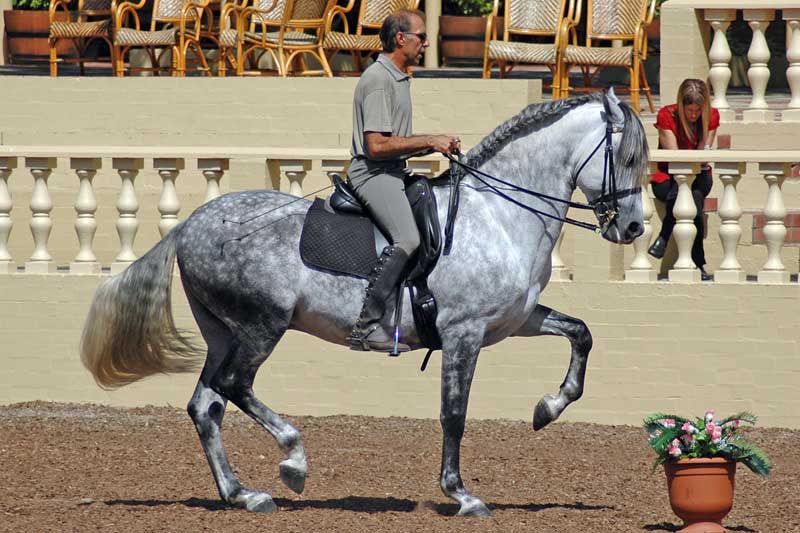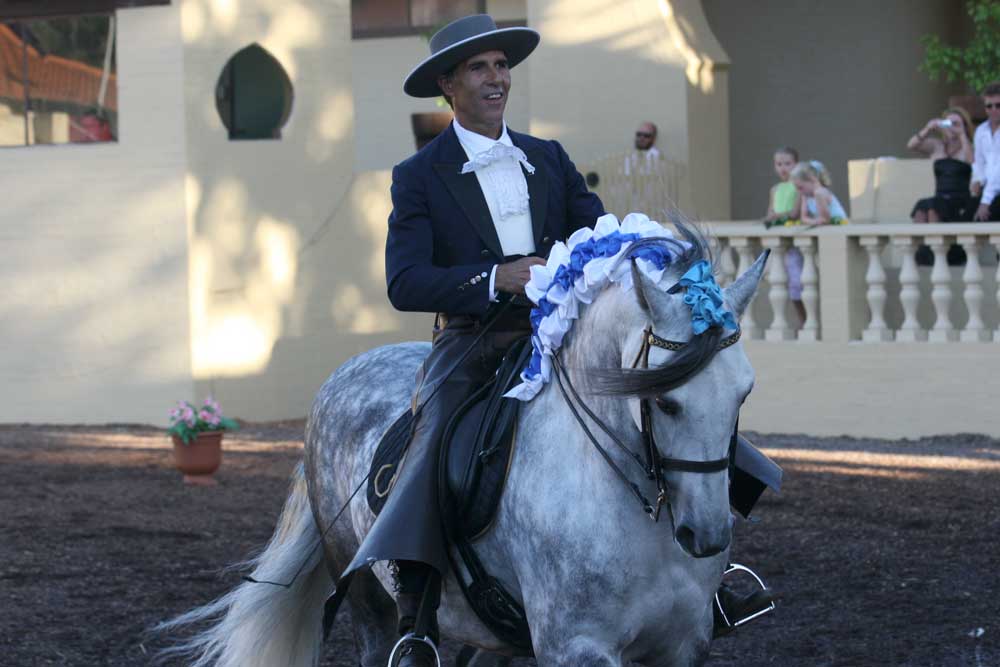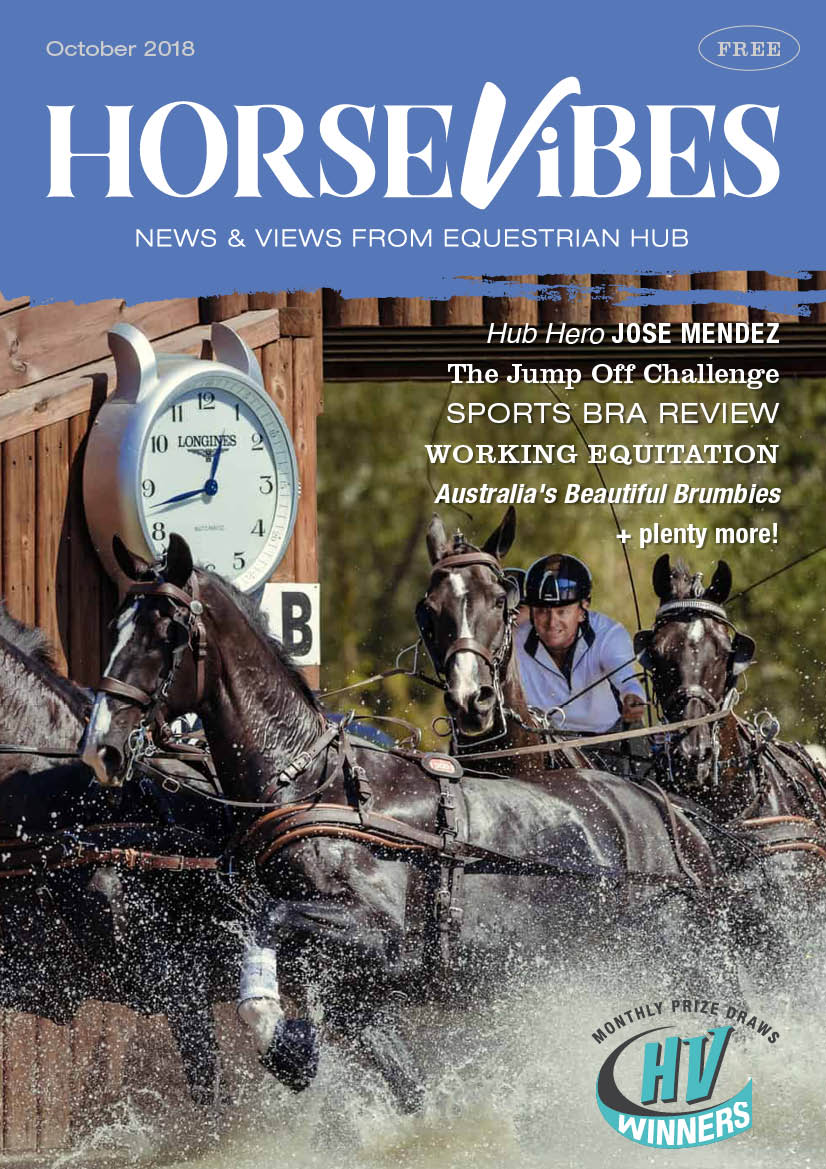Respect for, and partnership with your horse are key to Jose’s approach to training horses and riders around Australia, the United States and England, writes Jane Camens.

Always remember ASK , says one of Australia’s master horsemen, Jose Mendez: The word is emblazoned on his jacket. Below the capitalized letters he has unpacked the meaning: Appreciation, Sincerity, Kindness.
Jose moved to Australia at the age of 19 from southern Spain. Now in his mid-50s, he’s worked with horses all his life, starting on his family’s property and later, from the age of 12, at the Royal Andalusian School of Equestrian Art in the city of Jerez de la Frontera. The school is famous nowadays for its dancing horses performances, but when Jose began it was a family business, concerned mainly with supplying horses to men who worked the bulls. Along with full board and the friendship of other student trainers who are now among Spain’s best horsemen Jose was pleased to earn the equivalent of about $15 a month, most of which he sent to his mother. The years at the school cemented my skills in the art of classical horsemanship, he says. It was an essential learning period.
At the age of 19, Jose took a six-month leave of absence from the school to join his older brother, Monolo, in Australia. Monolo had trained at the same school and, wanting to see more of the world, had taken up an offer of a three-year contract with El Caballo Blanco in Perth. By the time Jose was invited to join him, El Caballo had a lot more horses and not enough trainers.
I loved Australia, Jose said. He also fell in love with Fay, who worked at El Caballo and whom he later married. Australia became Jose’s new home and now, nearly 40 years later, he and Fay run their own classical riding school, the Mendez Equestrian Centre at Tallong in the Southern Highlands, about an hour’s drive from Sydney. It had always been my dream to have my own place, he says.
It was a long journey from his arrival in Australia to the amazing reputation he now enjoys. Among the highlights were being selected in 1986 on the beautiful Andalusian, El Caballo Blanco Cadiz, for the World Equestrian Games in Toronto. In the early 1990s he represented Australia three times in international competitions on his magnificent.
He hasn’t competed for a while because he’s so busy working horses and training riders at his equestrian centre as well as giving clinics all around Australia, travelling regularly to Swan Hill, Geelong, Murwillumbah, the Sunshine Coast, the Gold Coast and Gosford. He has also been travelling twice a year to America to give clinics down the east coast of the United States. I’m not doing that this year, because I want to focus here, he says. I have enough work in Australia, which is great.
Jose has performed in front of thousands of people with different horses. With his soulmate horse Fortuno he performed in the Spanish opera Carmen in Australia and New Zealand and Singapore. With the beautiful horse Nevado he performed many times throughout Australia and New Zealand. He gave demonstrations at Equitana in 1999 and 2001 and has featured in numerous television commercials. Sometimes I’d have to do a quick wardrobe change from dressage tails which I wore to compete in, to my performance Spanish costume, then change quickly back into tails for the rest of the competition, he laughs.
Cupboards in the Mendez home are full of ribbons and prize rugs, testament to the long journey they’ve taken to arrive where they are today. Jose rarely shows people these cupboards. There are so many stories in there of events and spectacular horses he’s partnered with. He says he doesn’t much like standing in front of an applauding crowd, taking credit for something he couldn’t have achieved without whichever horse took them to that glory. He prefers to take the horse for a walk and perhaps lie on the grass to bask together with his horse in their shared triumph. I’ve been fortunate to work with and own many beautiful horses and I have loved them all. I look on all horses as my teachers, Jose says.

A typical day for Jose is to ride (in training) five to eight horses and give between two and four lessons and he would love to find a top-level competition horse again. I have several possible Grand Prix level horses, but I don’t like to predict, he says. I ask him about the importance of his motto: ASK Appreciation, Sincerity, Kindness. The horse deserves more respect than most people give them, he says. They are not machines. They are compassionate beings.
He talks of the need for slow learning, or of ot being impatient for the right outcome, because to overload a horse with too much will only confuse him. He speaks of learning the alphabet and how a child has to learn each letter one at a time, making the analogy of how a horse needs to be taken gently from one step to the next. He can watch a horse under its rider and see immediately that the horse hasn’t been taught the basics and has, for instance, been forced to bend when it’s not yet natural for him. Impatience being a trait of this rider (myself), Jose spent three-quarters of an hour helping me and my little quarter horse learn how to ride a circle correctly. Yes, it’s basic, but it was a valuable foundation lesson.
I can help people understand. Appreciate the horse. Don’t just pick up the reins and ride, he says. You pick them up and say thank you for letting me be on your back. You do this with sincerity. If the horse does something naughty, tap him with the whip to guide him. Horses are never wrong. They only do what they know how to do. When they do something well, give him a pat. Tell him he’s a good boy. Treat him with kindness. You will get the reward.
A horse has a great memory. After the elephant, the horse could be the second. He remembers who it was who punished him and who was kind. The horse can see clearer than we can about many things. The memory is not just the brain. It is stored in the muscle. If it was just in the brain, you could play your training DVDs in the stable and he’d learn. No, he has to feel it in his body. He learns with repetition. He learns rhythm, the paces, commands and aides. If I ask him to do something in a different way from one day to the next, it’s difficult for the horse to understand. You start with rules and repetition, like with little kids learning to paint a picture. They learn to join the dots. You repeat the exercises pretty much every day.

So, with my circle riding, they can get bigger or smaller, but they must be true circles, done at the same rhythm. We ride around a clock face, aware of where the numbers 3,6,9 and 12 are. Without pointers, says Jose, It’s like walking randomly around the city without landmarks.
Fortunately for Classical Dressage enthusiasts around Australia, Jose Mendez is there to give us those pointers.
You can contact Jose and Fay at their centre. Mendezeqcentre@bigpond.com.au
This article was published in HorseVibes October 2018





